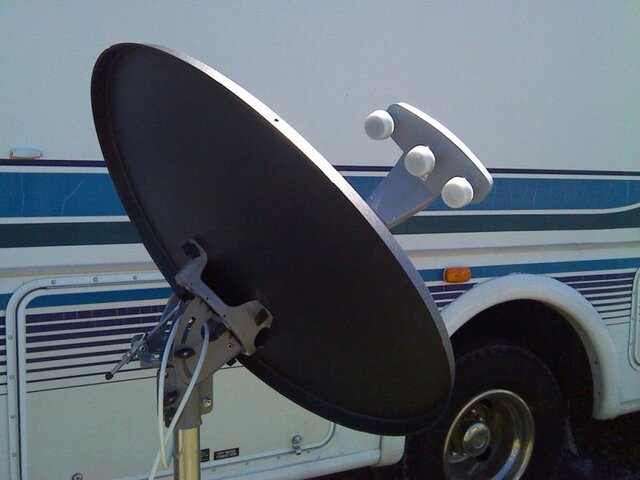Your sat finder is peaking on whatever LNBF that is electronically connected to the coax. If you are not forcing the LNBF selection, like setting the receiver to satellite 119 in the Point Dish page, what you are observing is what I was when I scrapped the cheap meter and got a meter that allowed me to select the LNBF with a 22 KHz tone, a Acutrac 22 Pro.
If you have the meter connected inline with the receiver and the dish, which you need to do to get the line voltage, then it doesn't matter which coax cable from the LNBF head you are connected to because the receiver can be selecting a different LNBF.
And when I had the VIP 622 and trying to force a LNBF selection, I found I couldn't trust the Tuner 1/Tuner 2 connection to be Coax In 1 and Coax In 2 so I set both to satellite 119.
Spending money on a meter is a choice of your time. Since I installed a Trav'ler after over 4 years of putting up the tripod about 40 times a year, I still have the tripod for when the Trav'ler has tree interference, and by nature, if the Trav'ler is blocked, the tripod needs to be away from the RV. A good meter says you can accurately point the dish where it is. I also use the tripod for EA PTAT HD Locals access when necessary.
The Acutrac 22 Pro aimed on a satellite but I needed to use the Switch Check to verify if it was the correct satellite. When the battery of the Acutac 22 Pro dies, I invested in a First Strike FS-1 which not only selected the 119 LNBF using the 22 KHz tone but also did a verification of the satellite. Still did Switch Checks as good policy.
The FS-1 did the job until the first time I set the tripod up after putting a Hybrid LNBF head on the DPP 1000.2 dish. The FS-1 could not deal with Hybrid LNBF head. I reverted to using the signal meter on the Hopper and made another discovery, the signal strength meter is useless until the satellites are locked in, a Catch-22 situation. I did a lot of trial an error on eye-balling the dish until I got it in the ball park, then did a little tweaking with the Hopper signal strength meter.
After a lot of research I found that the Applied Instruments people had the meters that would work with the Hybrid LNBF head. New, pricey as all-get-out but probably reasonable for a professional installer. Being a very active amateur, I got a used Super Buddy 29 off of eBay. First use found the reason for the Super Buddy 29 being on eBay was the battery was worn out. For the rest of the season, I dragged a power cord out to where I was using the Super Buddy. During the winter I sent Super Buddy to Applied Instruments for a new battery and a new faceplate. Even with my new battery and faceplate, my investment was half of the current Applied Instruments meter.
This year I had a failure on the relatively new Trav'ler, just out of warranty. Quite surprised as the Trav'ler on the fifth-wheel is 8 years old and working fine. I had to send it in to Winegard and had to schedule a removal and waited to get to a place I could reinstall the turret. The jest of this tale is that I had to put the tripod up 22 times this year, so far, and have really gotten to love it.
The Super Buddy 29 has all the setting for the dish adjustments inside and that included when we were in Canada last year. At the time satellitepointer.com didn't have Canadian Zip Codes but the Super Buddy 29 did. Aiming the dish is incredibly easy. Set the mast vertical, set the Skew on the dish, mount the dish, set the Elevation which is easy for me because I have an Align-a-Site for easy Elevation and compass viewing. Move the dish into the general area of the Azimuth, swing the dish until I get a popup on the signal display, which leaves a narrow history line of the best signal it saw during the swing. Move the dish back so the signal strength display is the height of the best seen number, and see the Locked display. Press ID and the satellite is verified. Step thru the other LNBFs and ID each and be done.
I wish I had the Super Buddy 29 from the beginning. Now I only do Switch Checks when I switch between the tripod and the Trav'ler or when I change the LNBF head on the tripod.
To bad the manufacturer of the Align-a-Site went out of business and are impossible to find. It really makes setting a dish up a lot easier. I got mine when I up also putting up a Hughesnet Satellite Internet dish on a Dusty Foot tripod which wasn't a modified surveyor tripod and only the Align-a-Site gave any setting reference. The periscope function is great as you look thru to see what the aiming LNBF is seeing. When in doubt, I swing the dish left and right to look for trees that could interfere with 110 or 129. I use the Align-a-Site to walk round looking for a place to put the tripod.
The closest thing I have seen to be close to an Align-a-Site is the
Satellite Dish Aiming Scope from TV4RV.com except the Scope doesn't adjust for Skew but does handle the 15 degree reflection angle.




